EDUCATION
IN

IN

Healthy Food curriculum takes Armijo students from garden to kitchen to video room
Suisun Valley prepares for return of Passport Sunday



Publishers: Foy S.
Editor: Glen Faison

and
Advertising Director: Louis Codone
Project Manager: Nancy Meadows
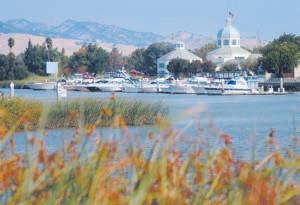



Distribution: Bob Franks
Contributing Writers: Todd R. Hansen, Susan Hiland, Matt Miller


Photo Editor: Robinson Kuntz


Nico James-Singh and Jalia Her share a vision for their futures. Each wants to make films – or a similar vocation – as their life’s work. They even teamed up to take second place in a recent video contest, which was good enough to move them onto the state competition.
They are members of the Multimedia Academy at Armijo High, with Her, a senior, serving as president. They also find themselves among 22 of their club mates and six other Armijo students in the first-year, after-school Healthy Food Program.

They are learning how to grow food, prepare it in the kitchen – and closer to their own pallets – produce a video or some other multimedia piece about the experience.
They meet from 2:45 to 4:45 p.m. each Wednesday.
Three groups of five students were busy March 1 preparing a stir-fry dish with a scallion ginger sauce. Several students were videotaping the work, another was taking photographs and still others were jotting down notes in their work journals.
But all eventually do cook – collaborate on the preparation and how

 PHOTOS BY AARON ROSENBLATT
PHOTOS BY AARON ROSENBLATT

in Chicago.
“I try to give them a lot of the basics that I had in culinary school,” said Oelsligle-Johnson, which begins with safety, sanitation and knife skills.
Getting the food ready to cook is an art form in itself.
Of course, the students must also learn how to use all their senses, and trust them.
Her describes herself as a picky eater, so last week’s Moroccan spiced and roasted vegetables and couscous –tiny steamed balls of semolina flour –was not particularly to her liking.
James-Singh loved it, especially the couscous.
“This is a test of skills, and I have to challenge myself,” said James-Singh, who used the home school time during the Covid-19 pandemic to improve and polish his multimedia skills.
David Avery heads up the Multimedia Academy, having taught ROTC at Fairfield High for 13 years, then used his GI Bill to learn about film and video production.
He said he is also getting an education now, as the students clue him in on what is out in their world, such as mukbang –a Korean online eating show.
“And I’m trying to get them to write,” he said.
The one thing that has surprised Avery, he said, was “how much the kids really do like the cooking part of it.”
The three-kitchen classroom in which they work is borrowed from a special education independent life skills course taught by Michelle Bolden. It includes cooking skills, personal finance lessons and washing and drying clothes among other abilities they will need. They even help the Healthy Food
students with that chore by cleaning the aprons and towels and other items that need washing.
The students go out in the community and work a set number of hours each week, for which, of course, they do get paid, and they work in the same garden the Healthy Food students use: the Jardin de la Esperanza, or Garden of Hope.
“We started to talk about it in 2018 and installed it in 2019,” said Sylvia Herrera, the “garden teacher,” who also heads the Garden Club that started the garden project. She teaches freshman and junior English.
“I definitely incorporate (the garden experience) into my classes,” Herrera said.
Paris Thompson, a freshman, talked about the connections she has learned about: How the work they do in the garden connects with the work they do in the kitchen, which in turn connects with other life experiences.
They have even learned how important their senses are in the garden.
Wendy Heredia, a junior, agreed, calling those connections “with the world and the community around you; it’s a real eye-opener.”
Other students talked about the relationships they are building. Because so many are part of the Multimedia Academy, they were aware of each other,
The topic of instruction March 1 was the potato.
The Healthy Food Program is run through Sustainable Solano, with funding from the Solano County Public Health Division and a state Department of Food and Agriculture grant.


There are 30 students in the program – chosen from 60 applicants. When 15 are in the garden, the other 15 are in the kitchen. Each receives a $150 monthly stipend, but there are no academic credits applied. The stipends come from Public Health program funds.
The students will continue the weekly routine through March into April and then focus more on their multimedia project. The best of those will be used to educate the rest of the student body on healthy living, and will even be presented to the community.
That will include a program website they are building now.
“Ms. Allison Nagel, the tireless director of Sustainable Solano, working with the amazing Armijo High School College and Career adviser Ms. Sandy Anderson, and Armijo High teacher Ms. Herrera have forged a powerful partnership between school and community that is a model for teaching and learning and community engagement. As principal of Armijo High School, these are the types of relationships that allow students to thrive and benefit the school and society,” John McMorris noted in a written comment.
Others involved in the program include Lauren Gucik and Noah Galgan from Sustainable Solano, and Anthony Gonzalez, another multimedia instructor.










Sierra Cecchini was a sophomore when teacher Sarah Erhman introduced her to the world of environmental science at Dixon High School.
“I was introduced to subjects I had never even heard of,” said Cecchini, who went on to study environmental science at what was then California State University, Humboldt – now Cal Poly Humboldt.
She was heading a Solano Resource Conservation District team Feb. 16 in a Watershed Explorers event at Sandy Beach County Park in Rio Vista. wAnd like Erhman did for her, she seemed to do for at least one of the 50-plus D.H. White Elementary School thirdgraders who endured cold temperatures under gray, threatening skies. They did not care.
“I think teachers always have the potential to have an impact on some students,” said Erhman, now O’Connor, who is principal at Santa Rosa Middle
School. “And I’ve always believed environmental science should be a subject that is required,” said O’Conner, who said today’s climate and environmental landscapes make it more true than ever.

Fischer Vancil was in Cecchini’s group discussing the watershed and how things that happen in Rio Vista can affect the Sacramento River and other waterways, as well as the wildlife.
The students were tasked to write a short story about what happens when trash is dropped in the city, and unlike most of his classmates, Vincil made himself the villain: Dropping the trash, which went into a storm drain only to be kept from polluting the watershed by the hero of the story: Cecchini.
“I’m glad I’m not the villain in your stories as much as I thought I would be,” said Cecchini, who has been the district’s assistant Education Program manager for two years. She started as a seasonal educator, and has been working with children in natural settings for six years.
Cecchini’s own story was a tale of how a candy wrapper became wrapped around a bird’s wing, endangering the animal’s life.
The watershed station was just one of three subject stations set up at the park. There were
also two stations at which students looked at what educator Meagan Van Schmidt called biofacts.
“Biofacts are little items that come from nature,” she told the students. “They are not artifacts because humans did not create them.”


A rattlesnake tail certainly caught the attention of many of the students, but at a second station, students took their turn at guessing at what kind of animal belonged to the skull on display – investigating possibilities based on size and the kind of teeth it showed. The guesses ranged from rhinos to coyotes to aliens.
There was also a station at which the students planted native plants, among them purple needle grass, and a pair of flowery plants: yarrow and gum plant.
Jenny Lindsay, a 20-year veteran of the classroom, brought her third-grade class to the event, but her ties to the program go much farther back.

“In fact, when my son was in third grade, I was a chaperone when they went to Rockville park,” Lindsay said. Her son is now at Cal Poly San Luis Obispo.




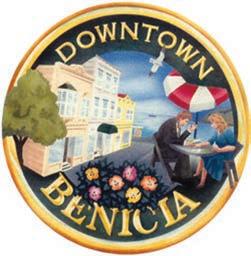
“I think it’s great how they do the pre-work,” said Lindsay, noting the study books and other classroom material the students get leading up to the field trip. “And its hands-on, and that’s what I really like.”
The students brought their journals with them on the field trip, writing down their observations and drawing illustrations.
About 300 plants were put into the ground by the students, and more than 10,000 plants will be added to Solano County





















•Courteous staff available twenty-four seven.


•Over half a century of service with thousands of satisfied customers.




•Three year interest-free before need planning for all budgets.
•Reception room for use at no additional cost.
We are the largest provider of quality services in Solano County. There must be a reason! Call our experienced staff for quotes.

•Guaranteed prices
•Cremation Services








•Private boat charters

M


•Price quotes by phone
•More services for a lower total cost
•Reception room with kitchen
community improvement awards and ethnic service awards than any other funeral home owner in the U.S.A. ner U.S.



parks through the Watershed Explorers program this year.
That program includes 13 events at five locations, with the final seven scheduled at Glen Cove Waterfront Park in Vallejo. The other sites were Lagoon Valley Park in Vacaville, Valley Glen Pond in Dixon, and Rockville Hills Regional Park in Fairfield.








The resource district works with schools in all seven cities in the county. It offers other programs for different grade and age levels.



“The overall goal of the program is to have students explore their area’s watershed,” Cecchini said.
The idea is for the students to un-










derstand how various elements of their real-life environment interlink, and the relationship those have with the watershed. They learn about the effects of pollution, drought and other influences.
“These (Rio Vista) students are particularly unique because they are living right on the (Sacramento Watershed) and learn how it connects to Suisun Bay and then eventually out to the ocean,” Cecchini said.

“And there is nothing like seeing them step off the bus and there is a sense of wonder,” she said.
For some, it will be the first time they look into binoculars or a stereo microscope to look at invertebrates, or hold a turkey feather.
“And it gives me a lot of hope,” said Cecchini, knowing the care of the environment will be in the hands of some of these youngsters. DS









The Solano Transportation Authority’s (STA) Solano Mobility Call Center provides personalized assistance and information about transportation options to get around Solano County and beyond. In addition to providing commuters and Solano County employers with information on a variety of transit services and incentive programs, the Call Center provides seniors, people with disabilities, veterans and students with a range of mobility options.
Below is a list and information on some of the many programs offered by Solano Mobility.
Older adults, veterans and people with disabilities
• Americans with Disabilities Act (ADA) Eligibility Program
• Intercity Taxi Card (ITX) Program
• Medical Trip Concierge Program
• Veterans Mobility Program
Getting around Solano County
• Clipper Card Sales
• Transit Information
• Travel Training
• Transit Trip Planning
Options for commuters
• BikeLink Locker Sales
• Carpools
• Clipper Card Sales
• Solano/Yolo BikeLinks Map
• Vanpool
Commuter benefits for employers and their employees
• Bucks for Bikes
• Commuter Benefits Program
• First-Last Mile Program
• Sustainable Transportation Emissions Program (STEP)
• Guaranteed Ride Home Program
Americans with Disabilities Act (ADA) Eligibility
The Americans with Disabilities Act (ADA) Eligibility Program determines eligibility for anyone unable to use fixed-routes public transit service because of their disability. ADA-eligibility allows access to curb-to-curb paratran-
sit service throughout Solano County, as well as participation in the Solano Intercity Taxi Program.
Intercity Taxi Card (ITX) Program
For ADA-certified individuals, this program offers the ability to purchase discounted fare for intercity taxi trips within Solano County using a prepaid debit card (PEX card). Eligible residents may purchase $100 of taxi funds for $40 ($20 if low income eligible).

Travel Training Program
Learn to ride public transit on your own or with friends with the Travel Training Program. This program provides one-on-one instruction and group training designed to teach people how to travel independently on fixed-route public transportation in their community. This free service teaches
everything, from how to read a schedule, to how to pay for your travel.
For seniors over 60 years old, the Medical Trip Concierge Services Program provides 20 reduced cost trips per month to medical and other essential appointments around Solano County, utilizing Uber and Lyft through GoGo Grandparent. A participant must be a resident of Solano County, 60 years of age or older and/or ADA-eligible. Customers pay 40% of the ride; only 20% if they qualify as low income. Wheelchair Accessible Vehicles (WAV) are available.

The Veterans Mobility program, started in April 2022, offers veterans of any age access to Veterans Affairs (VA) and medical facilities within Solano County, including Travis Air Force Base, as well as three specific locations in Contra Costa County, including the Martinez VA Clinic. This program also provides wheelchair accessible vehicles if required. Solano County
veterans can access VA and medical facilities by participating in STA’s subsidized Medical Trip Concierge (GoGo) Service or the Solano County Intercity Taxi Card (ITX) Program.
The First/Last Mile program assists Solano County residents and employees who have challenges connecting the first or last portion of their commute between 12 Solano County transit hubs and their homes or places of employment. Program participants receive 80% off their Lyft connection, up to $25.
The Guaranteed Ride Home (GRH) program provides an alternative option to get home in case of an emergency by allowing registered users to take a Lyft, Uber or taxi. The GRH program can be
used six times in a year, no more than three times in a month, for up to $100 per trip. Participants must have used an alternative transportation mode to get to work on the day they use Guaranteed Ride Home.
STA expanded the Guaranteed Ride Home Program in September 2022 to assist Solano Express riders whose route is missed or canceled. The new program is called Guaranteed Ride (GR), and participants register for the program by joining Solano Mobility’s Commute Solano Network for the Solano Express line they ride at commuterinfo.net. Participants receive an Uber Voucher valid for four rides during the month. Rides must be within 100 miles and cost less than $100.
With the high cost of gas, it makes sense to share your commute with seven to 15 people who live and work near you. Forming a vanpool is a great way to share the cost of commuting. New, qualifying vanpools traveling to or from Solano County for work can receive from $200 to $600 in monthly subsidies. Twenty new vanpools have recently taken advantage of this program traveling from Benicia, Dixon, Fairfield, Vacaville and Vallejo to Richmond, San Francisco, St. Helena and Treasure Island.
Everyone who lives or works in Solano County can win. Sign up for free at commuterinfo.net. Log your alternative commutes (transit, rideshare, active transportation, telework) to earn free gift cards. Be sure to include your home and work ZIP codes.
For more information about the Solano Mobility Call Center or a specific program, visit www.solanomobility.org or call 800-535-6883. from 8 a.m. to 5 p.m. Monday through Friday. DS
Wineries and other valley enterprises will open their doors in April for a rolling festival as the region celebrates Passport Sunday.

The annual event showcases what’s best about Suisun Valley, which on any given day offers city dwellers a place to escape crowded streets and see the country, buy fresh produce and taste wines.
Suisun Valley is located just west of Fairfield. It has fertile soils with a Mediterranean climate good enough to grow grapes for fine wines, just as in the neighboring, world-famous Napa Valley.
The valley has its scenic attractions, framed as it is by oak-covered hills, with acres of vineyards, orchards and other farming areas. It has buildings such as the 1900, one-room Gomer School, complete with bell tower. It has small commercial areas such as Manka’s Corner with



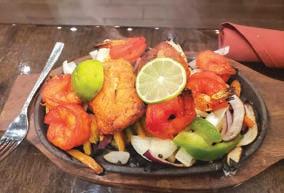






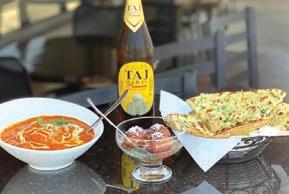
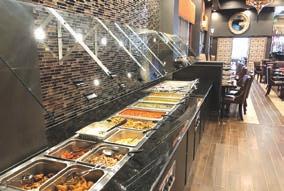



Passport Sunday 2023 info and tickets: http://suisunvalley.com.
BackRoad Vines: 707-759-0185; info@backroadvines.com; https://backroadvines.com.
Bally Keal Estate: 707-770-5434; info@ballykeal.com; https://new. ballykeal.com/winery/estatevineyards.
Caymus-Suisun Winery: www.wagnerfamilyofwine.com.
King Andrews Vineyards: http://kingandrewsvineyards.com.
Mangels Vineyards: 707-410-5392; www.mangelsvineyards.com.
Suisun Creek Winery: 805-704-2822; info@ suisuncreekwinery.com; www.suisuncreekwinery.com.
Suisun Valley Filling Station and Visitors Center: 707-863-1555; www. suisunvalleyfillingstation.com.
Suisun Valley Wine
Cooperative: 707-450-8603; www.svwinecoop.com.
Sunset Cellars: http://sunsetcellars.com.
Tenbrink Vineyards & Winery: 707-480-7334; www.tenbrinkvineyards.com.
Tolenas Vineyards & Winery: 707-372-1434; http://tolenaswinery.com.
Village 360: 707-863-0646; https://village-360.com.
Wooden Valley Winery: 707-864-0730; info@woodenvalley. com; www.woodenvalley.com.
Jelly Belly Candy Company: 800-9-JELLYBEAN, www.jellybelly.com.
restaurants and other businesses.
Wine is a big part of the valley. Suisun Valley in 1982 won federal recognition as the Suisun Valley Appellation, making the valley an American Viticultural Area. Grape varieties ranging from Sauvignon Blanc to Chardonnay to Gamay to Pinot Noir to Riesling are grown in the valley. Several small wineries have tasting rooms. In addition, other wineries have grouped together to run a cooperative tasting room on Suisun Valley Road.
A big winery is headed to Suisun Valley. The Wagner family, owner of Caymus Vineyards in Napa Valley, plans to build a winery at the very southern end of the Suisun Valley appellation capable of producing 200,000 gallons of wine annually. It plans to bring grapes and wines from other locations to the Cordelia Road site for bottling, as well as grow grapes there. But Suisun Valley is more than grapes. People can go there to buy corn, strawberries, dried fruit and nuts and other produce from small, family run produce stands. They can buy olive oil made from olives grown and processed in the valley. Solano County wants to get the word out. It has designated Suisun Valley to be-
come an agritourism area. Goals include creating several more small centers with businesses that cater to valley visitors.
This year’s event includes 11 locations featuring 14 wineries. The locations are BackRoad Vines at Village 360, Bally Keal Estate, Caymus-Suisun Winery, Il Fiorello Olive Oil Company, Jelly Belly Candy Company, Mangels Vineyards, Suisun Creek Winery, Suisun Valley Wine Cooperative, Suisun Valley Filling Station, Tenbrink Vineyards and Tolenas Winery, and Wooden Valley Winery.

Passport Sunday takes place from 11 a.m. to 4 p.m. April 23. It’s billed as a day of award-winning wines and wine country-inspired food across Suisun Valley. The event was canceled in spring 2020 due to pandemic lockdowns. The 2021 installment shifted to the fall, also as a result of the pandemic, before returning to its springtime schedule in 2022.
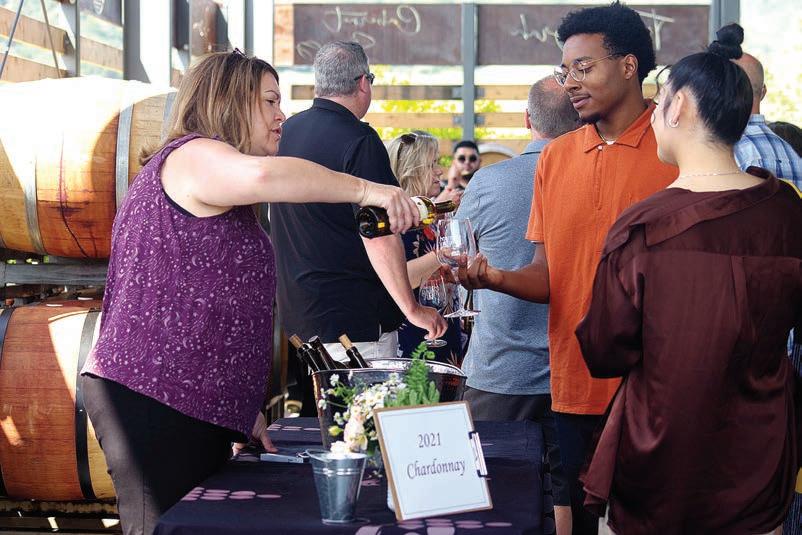
Ticket holders receive a passport map of the participating venues, a custom Suisun Valley wine glass to keep, food pairings from a different caterer at each location, special event day discounts and winery exclusives.
Passport Sunday 2023
participants include:
Bally Keal Estate, which is situated on 80 acres in the picturesque Suisun Valley American Viticultural Area. A total of 63 acres is planted to two varieties: Cabernet Sauvignon and Chardonnay. The vineyards are farmed organically with biodiesel tractors and in accordance with Fish Friendly Farming practices, designed to protect water quality and local habitat. Winery operations are designed to be net zero in carbon emissions with the estate’s 100,000 watt solar array, installed on the east end of the property, generating all of the energy used in the winery.
The winery and distillery is located at 4286 Suisun Valley Road.

Caymus-Suisun Winery carries the Napa County pedigree of the Wagner Family of Wines and the potency of the Caymus label. The winery has been described as the centerpiece to Solano County’s agricultural tourism; the piper to the valley of petite sirah. The winery has about 60,000 square feet of building
space and a permitted capacity to produce 200,000 gallons of wine annually.
Chuck Wagner founded the Wagner Family of Wines with his parents –Charlie and Lorna Belle Glos Wagner –in 1972. Charlie Wagner Sr. began as a home winemaker in the 1960s. Now Charlie Wagner, the third generation by name, and his sister, Jenny Wagner, are carrying on the legacy.

The Wagners deflect the expectations of their arrival – if not their own ambitions – of what the Caymus-Suisun Winery means to the valley and Solano in general. It is a work in progress, they say, with all possibilities alive and well. But the family emphasizes those possibilities are less its own business plan as they are the strategic master plan for the entire valley, a vision that realistically began with the Lanza winemaking family and the designation of the valley as an American Viticultural Area in 1982.
The winery is located at 4991 Suisun Valley Road in rural Fairfield.

Mangels Vineyards is dedicated to

making premium wines from selected varietals grown in the Suisun Valley. They strive for quality and enhancing the characteristics of each varietal when producing their small lots.
The Mangels family is continuing the tradition of winemaking in the Suisun Valley started by their great-grandfather more than 100 years ago. Gary Mangels purchased land in 1988 that would eventually become Mangels Vineyards. He planted his first vines in 1991. Gary and winemaker Gina Richmond founded Mangels Vineyards in 2009.
The winery is located at 4529 Suisun Valley Road in rural Fairfield.

Suisun Creek Winery is family owned and operated winery and vineyard. Brian Babcock, the winemaker is the fourth generation of grape growers in his family. He’s a native Californian and was raised on the same property that he farms today.
The family vineyard offers a wine club and private tastings in addition to 13 different varietal grapes.



Growing older doesn’t mean closing the book on adventures. At Rockville Terrace, we offer ample amenities to ensure your loved one’s needs are always met. Our amenities include a luxury dining experience, extensive library room, theater room, daily activities, full-service salon and spa, and much more.

The winery is located at 2434 Morrison Lane in rural Fairfield.
Suisun Valley Filling Station and Visitors Center is located at Mankas Corner, which has served as a tavern and meeting place for travelers and locals since the early 1800s.
The Filling Station hosts a vintage, gas station-inspired tasting room that provides locals and visitors with a friendly, hometown venue to sip artisan wine and craft beer made in Suisun Valley and beyond. Local artisan wine sold by the Filling Station includes Ryan Darrall Wines, Whim Cellars, and Capp Family Vineyards.
Suisun Valley Filling Station is located at 2529 Mankas Corner Road in rural Fairfield.
Suisun Valley Wine Cooperative boasts two distinct, family owned wineries: Sunset Cellars and King Andrews Vineyards.
Doug and Katsuko Sparks founded Sunset Cellars in their garage in San Francisco’s Inner Sunset District, Sunset Cellars believes in “Zen Zin” a minimalist winemaking style and respect for our grower’s efforts in the vineyards.
Winegrower Roger King and his wife Carol produce unique and boutique wines of Suisun Valley and Solano County. Small lot winemaking from the vineyard to the winery brings fresh vibrant wines to your palate. They grow, vint and bottle wines with limited intervention.
The co-op rotates wines on a weekly basis. It’s located at 4495 Suisun Valley Road in rural Fairfield.
Tenbrink Vineyards & Winery is owned and operated by Linda and Steve Tenbrink, who moved to Suisun Valley as newlyweds in 1982 to live and work in a rustic setting for the rest of their lives. They have farmed in Suisun Valley for most of their lives.
Over the years they’ve acquired farmland, which now includes approximately 60 acres of vineyards and 52 acres planted with walnuts, a variety of fruit trees and an heirloom tomato
patch. They grow several hundred varieties of tomatoes each year for fine dining restaurants.
In 2006, at the urging of renowned winemaker Abe Schoener, they decided to build their winery and focus on growing wine grapes. Today they handcraft 1,500 cases in Tenbrink’s red barn winery, which was added to the remnants of a 100-year-old redwood barn.
Tenbrink uses both traditional and new methods of winemaking to craft wines that are uniquely their own. Because they’re farmers first, they use a shovel on the label; they say it captures what they are all about. Tolenas Vineyards & Winery will also be featured there. Tenbrink is located at 4185 Chadbourne Road in rural Fairfield.
Village 360 is a new and premier destination in the Northern California wine country. It’s a full-circle community where people can make themselves at home. The venue offers a wide variety of activities and amenities that include a Makers Market with local vendors, Suisun Valley wine tasting from BackRoad Vines and both fine dining and café dining.
Village 360 is located at 4949 Suisun Valley Road. Its affiliation with BackRoad Vines brings wines crafted from hand-picked berries that are sourced from the winery’s complementary terroir, which ensures the premium foundation of the wines. Small-vessel fermenting paired with stainless steel and French oak barrel aging structures and balances the winery’s varietals.
The winery features a wine club, tastings, a vibrant calendar of events and bocce play on site. It is located at 2221 Julian Lane in rural Fairfield.
The Lanza family at Wooden Valley Winery has been producing awardwinning wines from the Suisun Valley Appellation for more than 85 years, well before there was a Suisun Valley American Viticultural Area.
The family has been in the winemaking business for three generations. The family shares a strong connection to the
land and an unrelenting commitment to improving the way they farm their vineyards and craft their wines.
Taking time to share food and wine with family and friends has always been a part of the family’s heritage. They warmly invite people to visit their winery and tasting room to sample their wines, learn more about the family’s history and experience for yourself some old-fashioned Lanza family hospitality.
The winery is located at 4756 Suisun Valley Road in rural Fairfield.
From being a local secret to worldfamous, the pint-sized jelly bean offers a variety of flavors and colors at the Jelly Belly Candy Company.
Starting in the lobby filled with jelly bean art and eclectic decorations, guests can tour the factory daily. Tours leave every 10 to 15 minutes and last about 40 minutes. Free samples of Jelly Belly products are available.
During the 40-minute walking tour, Jelly Belly guides will show guests a working factory where more than 150 different sweet treats are made. The factory, however, is not in operations during the weekends and on major holidays. Learn the secrets to how they create the legendary Jelly Belly jelly bean and discover why it takes more than a week to make a single bean. Jelly Belly features a Wine & Chocolate Experience that complements Passport Sunday options throughout the nearby Suisun Valley. The Jelly Belly visitor center is located at One Jelly Belly Lane in Fairfield.
Passport Sunday is designed for guests who are 21 or older. People will be asked to show identification at venues where alcohol is being served.
Tickets are $50 each and include a signature wine glass, featuring the event logo, along with a tasting pass to enjoy wine at all participating venues.
Passport Sunday is the largest fundraiser of the year for the Suisun Valley Vintners and Growers Association. DS








Sfornia’s 58 counties.
Vallejo, in the southern corner of the county, sits along San Pablo Bay and has the graceful Carquinez suspension bridge to take Interstate 80 motorists over the Carquinez Strait. Here, summer skies are often gray in the morning from the high fog that streams through the Golden Gate on the opposite end of the bay.
Benicia’s views are also dominated by water. The city sits along the Carquinez Strait and Southhampton Bay. Solano County is considered part of the Bay Area and the Vallejo/Benicia area shows why.
In the northernmost county near Dixon, the Bay Area seems a world away. The flat Central Valley land is dominated by agriculture. Summer temperatures often soar into triple digits and winter brings a type of fog called the tule fog. There are no major waterways to be seen, though there are canals that bring
try. Here, near the small city of Rio Vista, the Sacramento River and a network of sloughs are a watery highway for boats. Summer temperatures are hot here, unlike those in Vallejo. The Real McCoy II ferry takes travelers on Highway 84 over Cache Slough to Ryer Island, a farming community behind levees.
The western county has oak-studded hills and valleys, in places presenting an appearance similar to the Wine Country of Napa and Sonoma counties. Not coincidentally, this is Solano County’s own wine country, with acres of vineyards and several wineries in Suisun Valley.
The central county near Fairfield and Suisun City is a land of transition between the Delta and the bays. Among its features are Suisun Marsh, the largest contiguous estuarine marsh in the United States. Duck clubs dominate this land of tules and wetlands. State preserves feature such sights as tule elk.
Solano County, with 454,000
the county’s seven cities. Fairfield has established open space buffers between it and Vacaville to the north and Benicia and Vallejo to the south.
That leaves agriculture as the main land use in rural Solano County. Farmers grow everything from tomatoes to peaches to sunflower to alfalfa. Ranchers have sheep, cows and other animals. Crops in 2020 had a value of $357.2 million, according to the county’s most-recent crop report.

The county’s rural areas also provide places for recreation. People can boat and fish in local sloughs, hunt in Suisun Marsh and hike in Lynch Canyon, Rockville Hills and Lagoon Valley parks. They can camp along Putah Creek at Lake Solano park and along the Sacramento River at Sandy Beach park.
Solano County can also boast of being one of California’s original counties, established in 1850 along with the state.
Solano County has much to offer residents, visitors alike
Each community in Solano County has much to offer. Here’s a sample:

Downtown Benicia offers myriad festivals and events for all ages. The spring season offers plenty of activities, from a farmers market to various community celebrations and more.

MORE INFORMATION: 707-745-9791, www.beniciamainstreet.org.
The shores of Southampton Bay are home to one of Solano County’s few state parks. People come to Benicia State Recreation Area to walk, run,

cycle, birdwatch and fish. The state lists the Dillon’s Point marsh as an area in the park particularly favored by anglers. A few motorhome campsites are available, though no tent campsites. It has 2.5 miles of roads and paths. Benicia State Park is also home to the Forrest Deaner Native Plant Botanic Garden. The only other Solano County state park is Benicia Capitol State Historic Park, though the county does have state wildlife refuges.
LOCATION: Columbus Parkway exit from Interstate 780 in Benicia
MORE INFORMATION: 707-648-1911, www.parks.ca.gov/?page_id=476



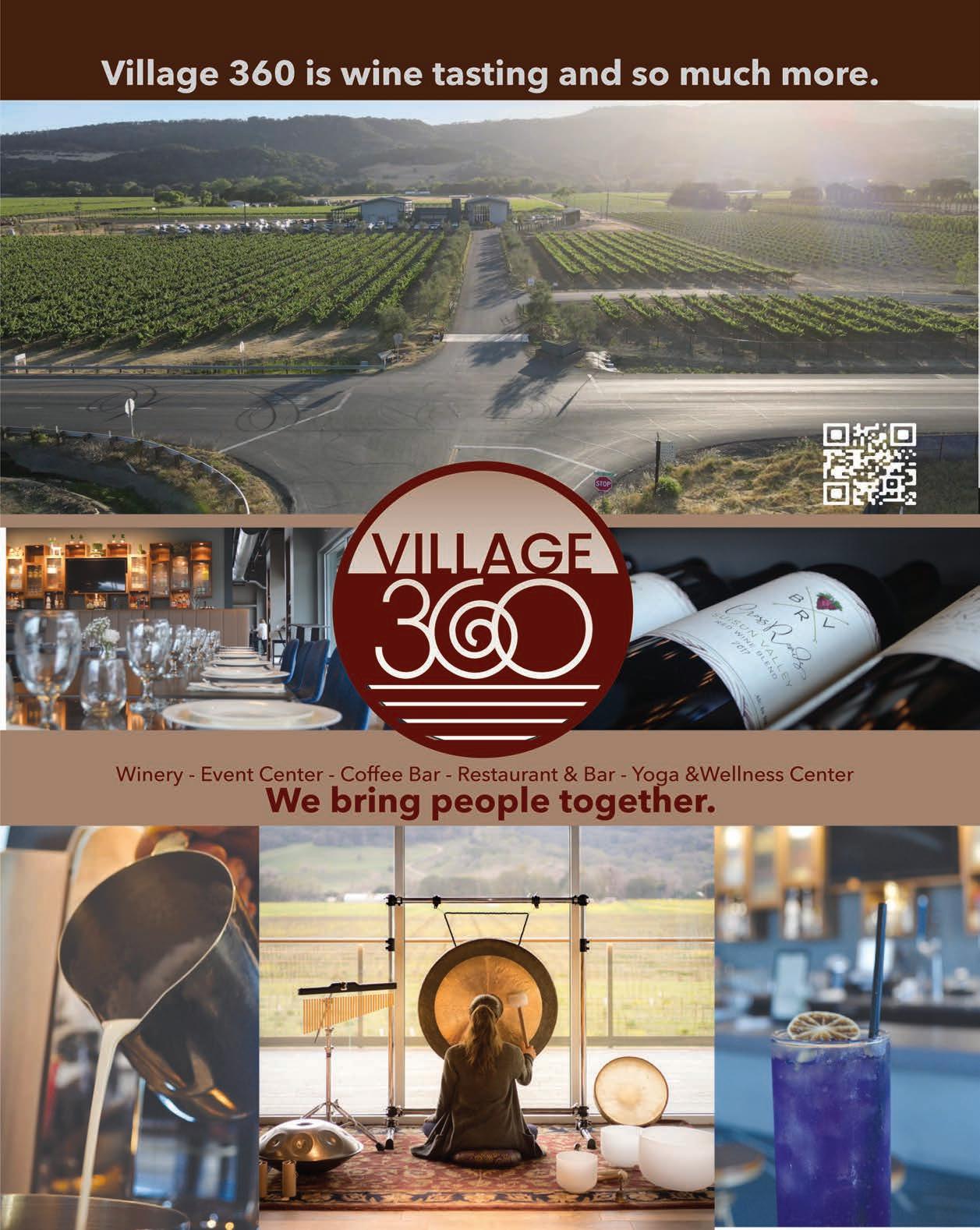
Benicia briefly served as California’s capital 150 years ago. Benicia Capitol State Historic Park commemorates the era of 1853 to 1854. The old capitol building remains and is open to visitors. Vallejo was the state capital before Benicia, but Gen. Mariano Vallejo failed to provide the promised buildings and lawmakers moved it. Benicia has a Greek temple-style capitol building, but this too failed to convince state lawmakers to stay in Solano County. Sacramento became the capital in March 1854. The Benicia Capitol building over the years served as a fire station, police station and even a dance hall. The Benicia Capitol is the only pre-Sacramento capitol building that remains.
LOCATION: 115 W. G St., Benicia
MORE INFORMATION: 707-745-3385, www.parks.ca.gov/?page_id=475

The Benicia Army Cemetery is the oldest cemetery in the Pacific states. It was the post cemetery for the Benicia Barracks, which from 1849 to 1857 served as the headquarters for the U.S. Army’s Pacific Division. The cemetery contains 212 interments dating from 1849 to 1958. These interments include U.S. military personnel, civilians, unknowns, foreign personnel (German and Italian POWs) and three military service dogs. The cemetery is on the National Register of Historic Places as part of the Benicia ArsenalBenicia Barracks Historic District.
LOCATION: Birch Road, Benicia
MORE INFORMATION: 707-693-2460, https://www. cem.va.gov/cems/nchp/BeniciaArsenal.asp
Located between the Sacramento River Delta and San Francisco Bay, the Benicia Marina is a jewel located on the north side of the Carquinez Strait, with spectacular views from every slip in the harbor. It offers guest berthing, power, water and a safe environment. It is also only a short walk away from downtown Benicia’s charming First Street and its shops as well as walking and bike trails. Guest boats must check in at the marina office for berth assignments. Call in advance for the availability of either transient or overnight berthing.
LOCATION: 266 E. B St., Benicia MORE INFORMATION: 707-745-2628, www.beniciamarina.net.

Lovers of antique fire equipment can see what is believed to be the first fire engine to arrive in California – the Phoenix Engine – at the Benicia Fire Museum. The engine dates back to the 1820s and is owned by the Benicia Volunteer Firemen. The museum is also home to the Solano Engine, the first engine owned by the volunteer firemen. The Benicia Fire Museum houses many treasures of fire service equipment and hundreds of related items. Admission is free. Donations are accepted.
LOCATION: 900 E. Second St., Benicia MORE INFORMATION: 707-745-1688, www.beniciafiremuseum.org
The Benicia Plein Air Gallery specializes in the work of local artists who capture the outdoor scenes in and around Benicia, the Carquinez Straits and the San Francisco Bay Area. Each month, the open-air gallery showcases the works of one of its many artists, with creations that range from classical landscapes to saturated pastels. The 5th Annual Paint Out event planned in August 2020 was canceled due to the pandemic and has not yet returned. The gallery responded by producing a brief video called “Painting en plein air in the time of Covid,” which may be viewed at the gallery’s website.
OIL
LOCATION: 307 First St., Benicia MORE INFORMATION: 707-297-5903, www.beniciapleinair.com


Sepay Groves Olive Oil, the oldest olive oil store in Solano County, offers an expansive variety of award-winning extra virgin and flavored olive oils and serves as an outlet store for the oldest operating olive oil producer in Suisun Valley, who arguably produces the best Tuscan extra virgin olive oil in Northern California. All oils and vinegars are bottled by hand in small batches to maintain their integrity, with the oils sold in their first year of life.
LOCATION: 364 First St., Benicia FOR APPOINTMENTS AND MORE INFORMATION: 707-434-8222, www.sepayoliveoil.com






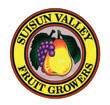


















The Dixon May Fair returns May 11-14. This year’s theme is “Spring has Sprung” and will celebrate the fair’s 146th year. Livestock will once again be at the fair, featuring young agriculturalists showcasing their skills. Talented artists, photographers, crafters, bakers and more will once again be able to show off their skills to the community during the four-day event. Carnival rides, live entertainment, food and fun are
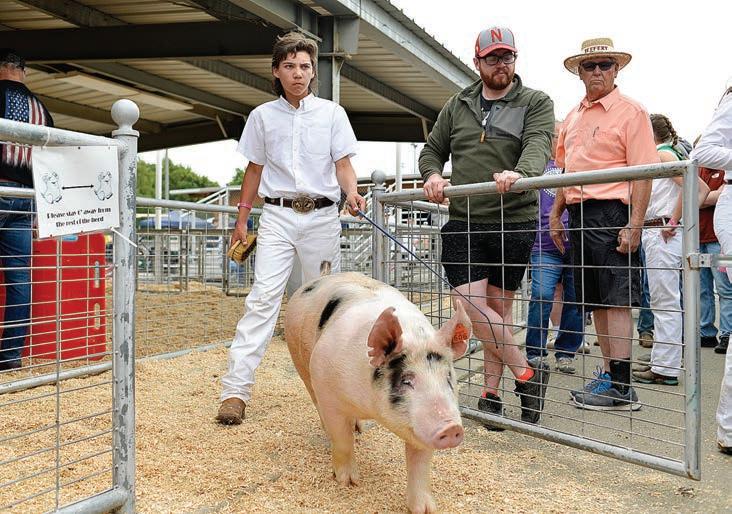
https://dixonmayfair.com

The Sacramento Valley National Cemetery is the seventh national cemetery built in California and the 124th in the nation. It opened

to burials in 2006. It is located on Midway Road between Vacaville and Dixon. The cemetery should serve the needs of the area for the next 50 years. It opened with 14 acres for interment of local veterans and their loved ones, and has steadily expanded.
LOCATION: 5810 Midway Road, Dixon
MORE INFORMATION: 707-693-2460,
www.cem.va.gov/cems/nchp/sacramento.asp
The Rush Ranch Open House is an annual event hosted by Solano Land Trust. This event is free and packed with fun for all ages! Explore this working ranch, walk its beautiful trails, see cows, horses, and sheep, browse for gifts from local businesses and try out your blacksmithing skills at the Blacksmith Shop!











Playing host to hundreds of community events each year including concerts, festivals and seminars and performances, the Downtown Theatre is the cultural hub of the Fairfield area. Also home to an art gallery, new works are shown each month at the center. Admission to the gallery is free during hours of operation. The award-winning, 360-seat theater received an exterior facelift in August 2018 with the addition of a state-of-the-art lighted marquee. The theater and other facilities can be rented out to host your special event as well.
LOCATION: 1035 Texas St., Fairfield
MORE INFORMATION: 707-940-0700, www.downtowntheatre.com

From being a local secret to world-famous, the pint-sized jelly bean offers a variety of flavors and colors at the Jelly Belly Candy Company. Starting in the lobby filled with jelly bean art and eclectic decorations, guests can tour the factory daily. Tours leave every 10 to 15 minutes and last about 40 minutes. Free samples of Jelly Belly products are available. During the 40-minute walking tour, Jelly Belly guides will show guests a working factory where more
the secrets to how they create the legendary Jelly Belly jelly bean and discover why it takes more than a week to make a single bean. The factory is not in operation Saturdays and Sundays. Tours continue when the factory is not in operation. Jelly Belly recently opened a museum on site that is open for tours for those who wish to extend their experience.
LOCATION: One Jelly Belly Lane, Fairfield
MORE INFORMATION: 800-9-JELLYBEAN, www.jellybelly.com
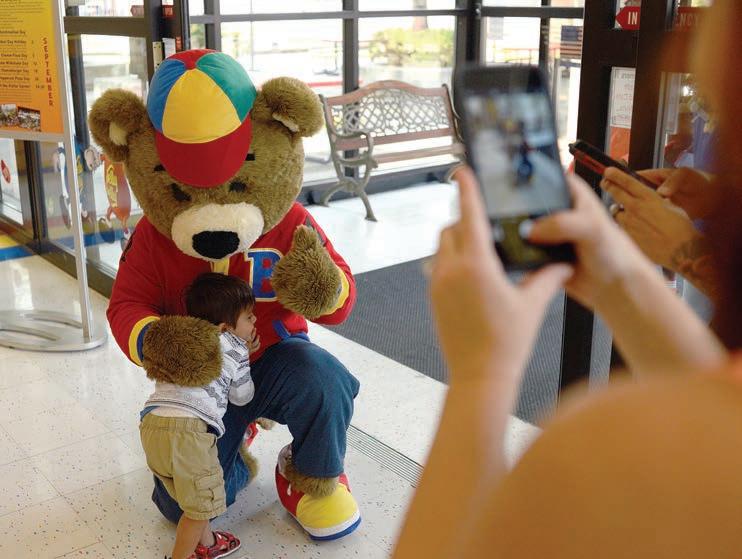
Solano Town Center mall is one of Solano County’s major shopping and restaurant areas. The two-story mall has about 130 storefronts, ranging from department stores to recruiting offices to movie theaters. It is also a destination for various walking clubs that want to escape the weather. Children can climb and explore the bright, colorful play area filled with animal characters, large puzzles and plenty of space to stretch their legs. Developed in the late 1970s and early 1980s, the mall has gone through various renovations through the years. The latest major renovation brought an $8.5 million, 33,000-square-foot dining court to the mall in April 2011. The mall was renovated end-to-end in 2006 at a cost of $20 million.
LOCATION: 1350 Travis Blvd., Fairfield
MORE INFORMATION: 707-425-1164, www.solanotowncenter.com

Whether it’s exercise, a birthday party or swim lessons, the Fairfield Aquatics Complex offers a lane or slide for all occasions. The center features a natatorium with retractable roof, a zero-depth entry play area, a lazy river current for fun and a six-lane activity pool with a slide and diving board. The outside shallow play area for kids includes slides, climbing structures, water-dumping toys and water-spray toys adjacent to a grass area for families to lounge and enjoy the sunshine. There is also a picnic

area for large groups to use for the day or rent the entire facility after hours for company parties, school field trips or special occasions. There is an indoor meeting room and party rooms for smaller groups to enjoy the facilities and catered to in a private setting. A concession stand provides hot and cold drinks and food.
LOCATION: Allan Witt Park, 1741 W. Texas St., Fairfield
MORE INFORMATION: 707-428-7428, www.fairfield.ca.gov
Sonoma Harvest Olive Oil & Winery’s stylish tasting room offers complimentary tastings of almost all of the available Sonoma Harvest food products, including its gourmet olive oils, vinegars, mustards, honey, tapanades, jams, sauces and more. A wine tasting includes the full flight and features four varietals. The tasting room features a well-equipped kids’ club so the little ones can be entertained by puzzles, games, and movies while the adults sip some wine, sample yummy bites and shop among wine country merchandise. Sonoma Harvest’s tasting room is open from noon to 4 p.m. Monday and Wednesday through Sunday, with curbside pickup available from 10 a.m. to 3 p.m. Tuesday.
LOCATION: 770 Chadbourne Road in Fairfield
MORE INFORMATION: 707-389-4815, www.tastesonomaharvest.com
The Travis Heritage Center holds an extensive collection of aircraft and artifacts detailing the history of Travis Air Force Base, airlift, space exploration and military air power. Founded in 1983, the center is surrounded by an impressive collection of restored historic military aircraft that includes the B-29 Superfortress, a Vietnam-era B-52 Stratofortress, an F-4C Phantom Fighter, a C-124 Globemaster II, a C-47 Skytrain and an F-86 Sabre fighter. Inside, there are exhibits containing artifacts, documents, aircraft models, uniforms, aircraft nose art and photos from the dawn of military air power in World War I to present-day military and humanitarian operations around the world. Due to post-9/11 security concerns, aviation lovers will need a base visitor’s pass to see the Travis Heritage Center.

LOCATION: Travis Heritage Center, 400 Brennan Circle, Travis Air Force Base
MORE INFORMATION: 707-424-5605, www.travisheritagecenter.org













































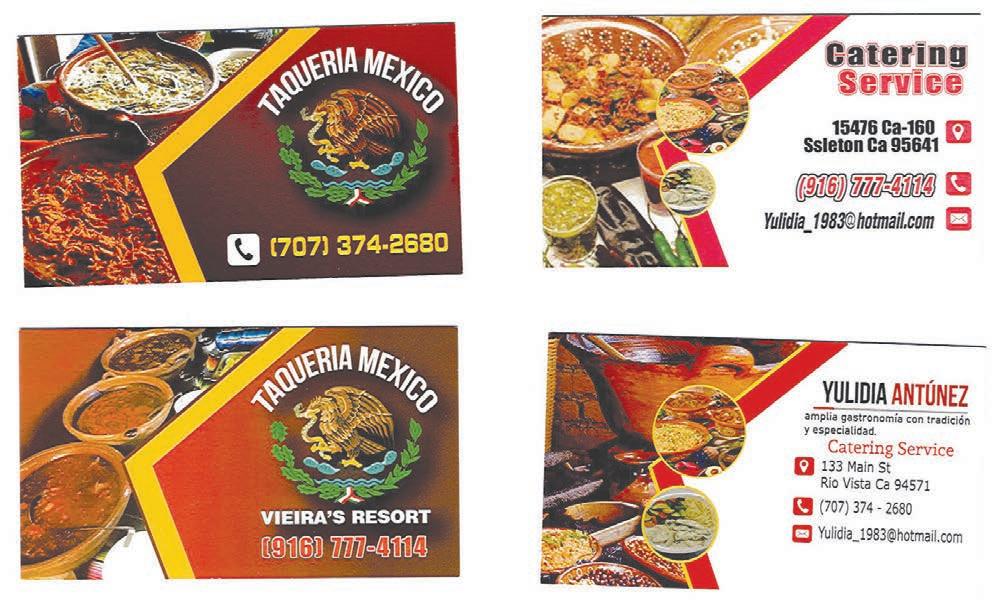















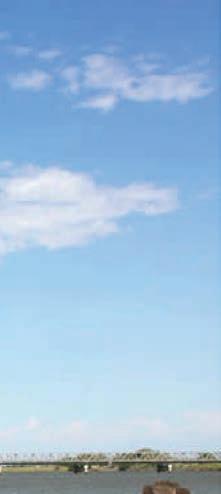



















A bevy of shops, restaurants and cafés beckon local residents and visitors to the Suisun City waterfront. Fishermen, dog walkers and people just taking a stroll can be seen at the waterfront almost daily. Much of the activity is centered around the Harbor Plaza at Main and Solano streets, which has hosted concerts and plenty of community activities. The waterfront is often referred to as “a jewel” of the community.
LOCATION: Main Street, Suisun City
MORE INFORMATION: www.suisunwaterfront.com

The Suisun Wildlife Center serves as a sanctuary for injured birds and wildlife and a place where people can learn about the natural world of the Suisun Marsh. It is located at the foot of Kellogg Street next to the Suisun City boat ramp. The center’s predecessor, the Wildlife Rescue and Release Services, began in 1977. The center relies heavily on volunteers who do presentations and guide field trips. It is also home to about a dozen nonreleasable raptors, raccoons, coyotes and other animals that help with the staff’s wildlife education program.
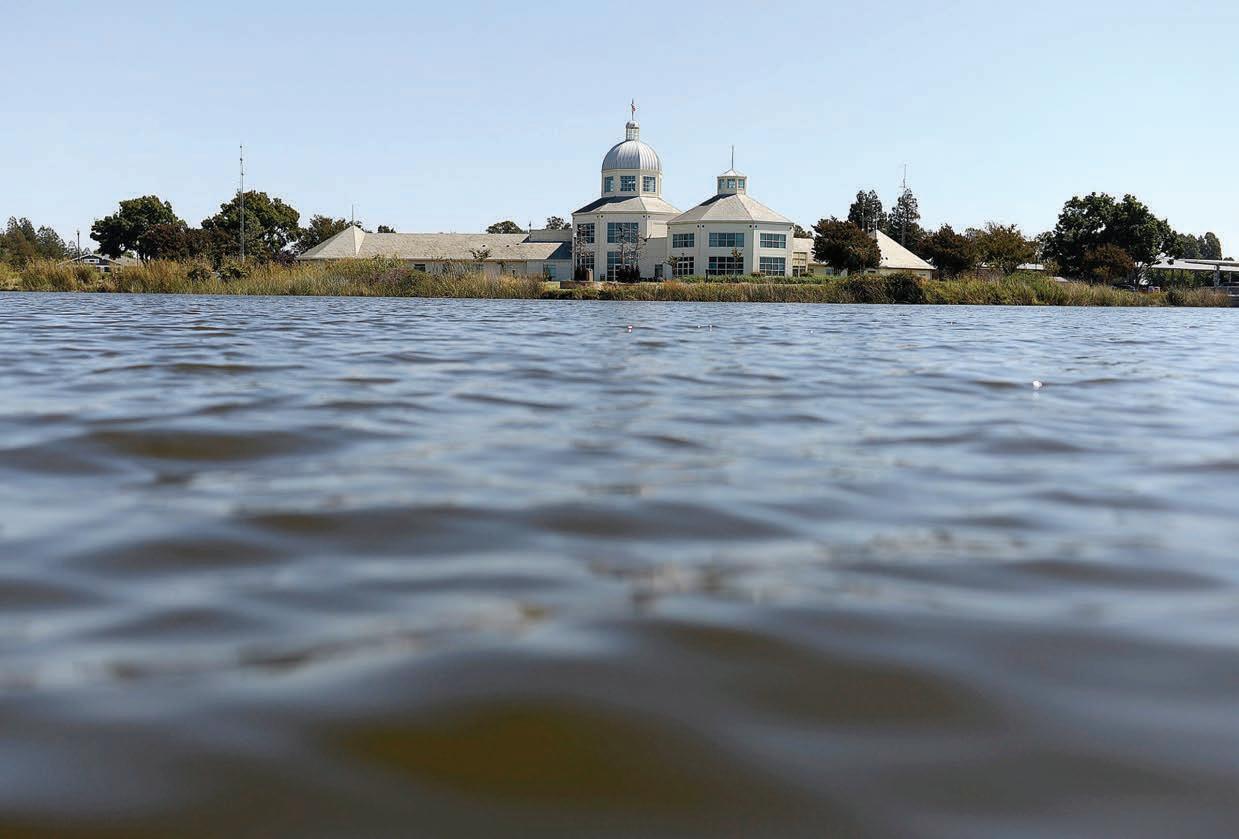
LOCATION: 1171 Kellogg St., Suisun City
MORE INFORMATION: 707-429-4295, www.suisunwildlife.org





































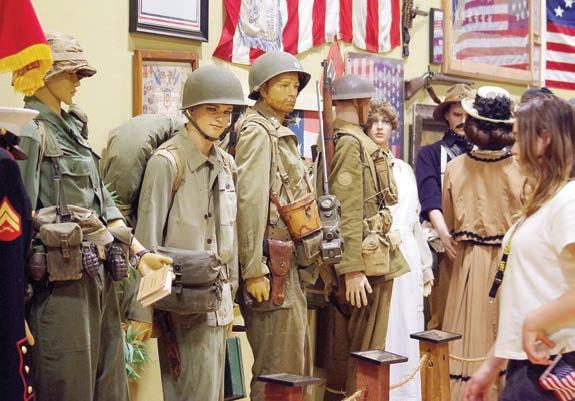
The American Armory Museum strives to educate future generations about, and impress upon them, the sacrifice, bravery and enduring significance of the U.S. military. Numerous vehicles are on display, with some available for rides. Various static displays are also set up to illustrate life in the field while in the armed forces. The museum features such military vehicles as the 1955 Larc amphibious cargo hauler, the M35A2 cargo truck, the 1944 M5A4 artillery tractor, the M936A1 wrecker and recovery truck, the FV433 Abbot self-propelled artillery vehicle, the HET 1070 heavy equipment transport, an Israeli M-5 half track armored personnel carrier, a Ford GWP jeep, the M561 Gama Goat amphibious vehicle and the Super Mack heavy-duty truck. Ask in advance about ride fees. The museum opened in May 2016. Admission is free, although donations are accepted. Open from 10 a.m. to 3 p.m. Wednesday through Saturday and by appointment. Ride fees for vehicles are to be determined and are subject to change without notice.
LOCATION: 4144 Abernathy Road, rural Fairfield in Suisun Valley
MORE INFORMATION:
707-389-6846, info@ americanarmorymuseum.org, www.americanarmory museum.org

Named after the small white flowers of the olive trees, Il Fiorello Olive Oil Company offers tours of the mill that produces the oils from the locally grown fruit. The family owned company produces artisan olive oil from the Suisun Valley and Green Valley orchards. Using a modern continuous-system olive mill, it can process 1,700 pounds of olives per hour. Tours give folks the chance to stand at the final separator, the cucciolo, as the olives are milled. They can dip pieces of fresh bread in the golden-green oil and savor the rich taste. Certain times of the year, Il Fiorello opens the mill to the public and processes what people bring in. There are also tastings available, as well as various classes throughout the year.
LOCATED: 2625 Mankas Corner Road, rural Fairfield
FOR APPOINTMENTS AND MORE INFORMATION: 707-864-1529, www.ilfiorello.com
Manka’s Corner is a small commercial area amid the farmlands of Suisun Valley. Solano County is promoting Suisun Valley as an agricultural tourist draw and Manka’s Corner is a key part of the plan, given that it has restaurants and shops where valley visitors can stop. The area’s name comes from Christley Manka, a pioneer to Suisun Valley around 1850. He established a tavern at what is now Manka’s Corner.

LOCATION: Mankas Corner Road and Clayton Road
MORE INFORMATION: www.suisunvalley.com
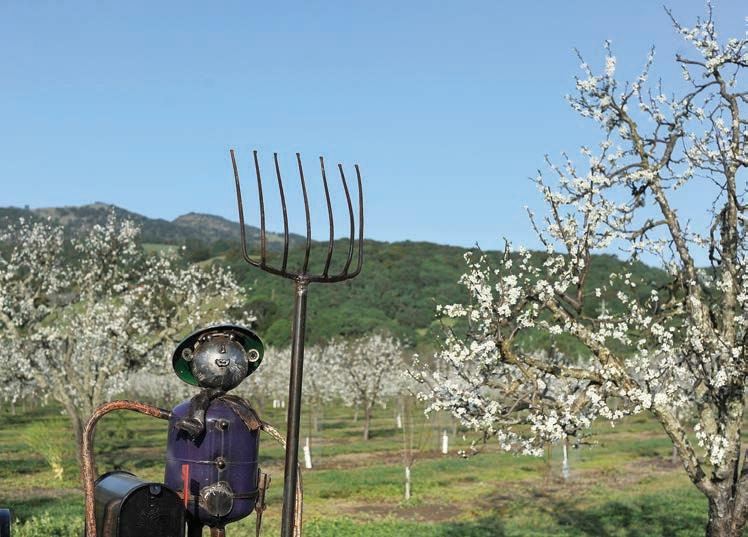


Home to an eclectic array of art and sculptures, Phil Glashoff’s farm in Suisun Valley also shows off the agricultural side, with a seasonal fruit stand and pumpkin patch. One of the area’s most prominent artists, Glashoff’s works can be toured by appointment. Those in the area can visit for produce in October. Much of the art is made up of salvaged rusty machinery, fire extinguishers, compressor covers, motorcycle tanks and other items that had been abandoned and scattered around the farm. The sculptures have brought Glashoff attention from around the world. Those who appreciate art find there is goodwill and humor in each piece.
LOCATION: 2489 Rockville Road, Suisun Valley

MORE INFORMATION: 707-427-8060, glashoffgallery@aol.com





































































































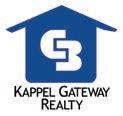
















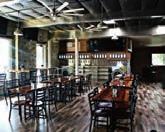












Spend the day, see some sights
If you’re looking for big horns – literally – look no further than Foster’s Bighorn Bar in Rio Vista. Along with an extensive menu of barbecue, steak, seafood and a fully stocked bar, the restaurant boasts a private collection of more than 250 big-game hunting specimens from Africa and North America. The collection was put together by Bill Foster in the 1930s and ’40s. Several exotic and prized animals from his travels to Africa, Canada and Alaska hang on the wall, including heads of an African elephant and giraffe. Foster, a native of Hayward, was involved in bootlegging. Running from the law, he moved his wildlife collection to Rio Vista, where it has remained for more nearly 100 years.
LOCATION: 143 Main St. Rio Vista

MORE INFORMATION: 707-374-2511, www.fostersbighorn.com
Located on the Sacramento River near Rio Vista, the half-mile-long Sandy Beach is a great Solano County location to cool off during the spring, summer and fall and enjoy some time outdoors throughout the year. It’s open the entire year and has a 24-hour boat launch, campsites and areas to picnic that include tables, barbecue pits, volleyball courts and a horseshoe pit.
LOCATION: 2333 Beach Drive, Rio Vista
MORE INFORMATION: 374-2097 (maps and reservation information available), https://www.solanocounty.com/depts/rm/countypark/ sandybeach.asp.


Nut Tree Plaza, next to Interstate 80 in northeast Vacaville, is an entertaining blend of the old and new, with a wide host of retail businesses sharing the land with a family oriented town plaza that features the restored Nut Tree train and a carousel. The plaza inherited the legacy of the original Nut Tree, which was founded in 1921 when the Power family set up a small fruit stand under a large oak tree beside the road that is now I-80. It grew into the most

toys, children’s rides, aviation books, souvenirs, gemstones and a post office. The original Nut Tree closed in 1996, only to be reborn as the Nut Tree Plaza, which offers a mix of more than 40 restaurants and businesses that includes the Fenton’s Creamery. Nut Tree’s town plaza typically hosts special events.
LOCATION: East Monte Vista Avenue at Nut Tree Road
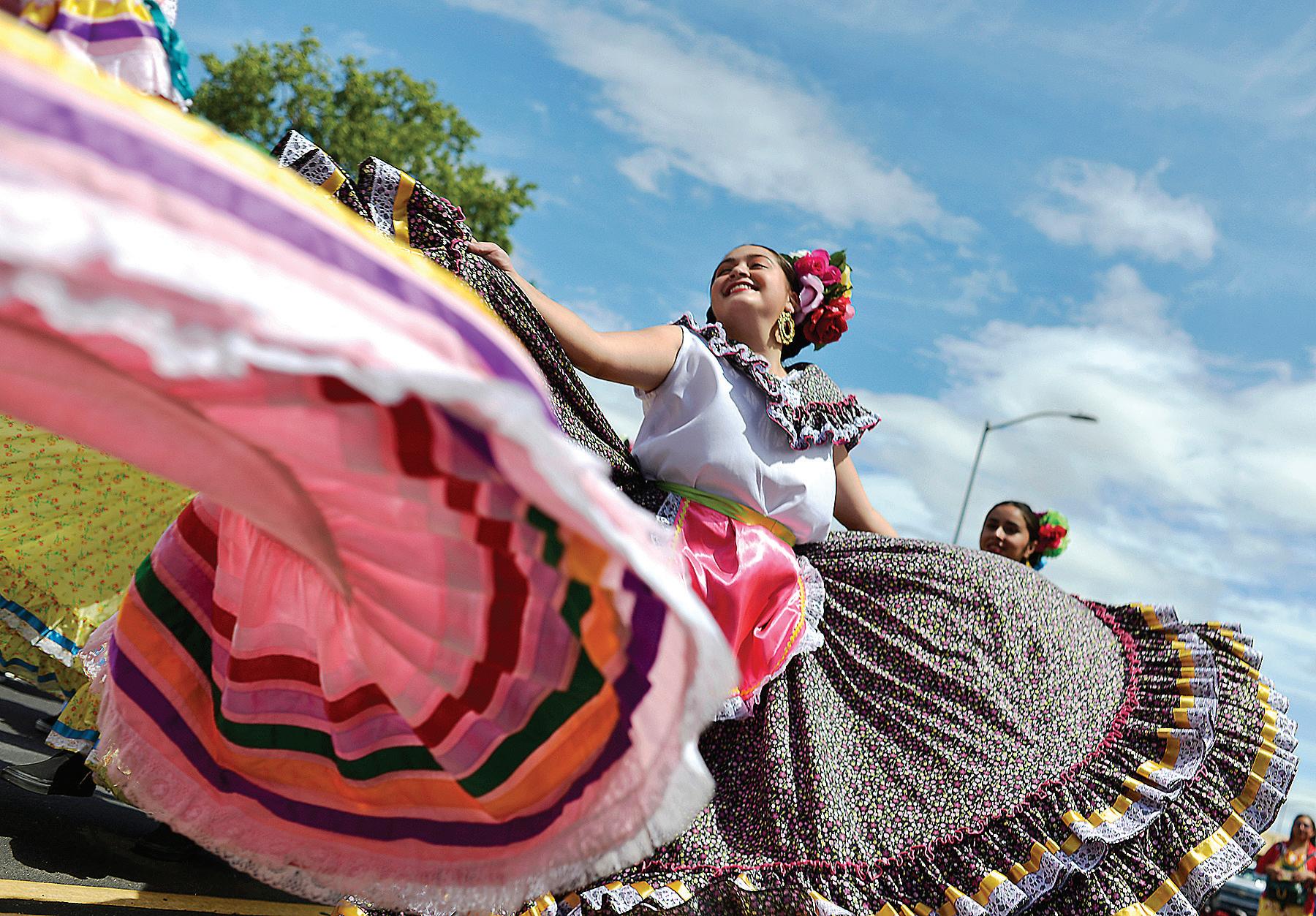
MORE INFORMATION: www.nuttreeusa.com
Clustered around the intersection of Merchant and Main streets, Vacaville’s downtown is an active and entertaining neighborhood with activities that range from summertime farmers markets and town square concerts to major community events. It is a historically well-preserved town center with more than two dozen restaurants, cafes and bars sharing the sidewalks with a healthy selection of small shops and businesses that run the gamut from bicycle stores and travel agencies to photo studios and fitness centers. The downtown’s business-supported activities include the mid-spring to mid-fall Certified Farmers Market each Saturday at the Creekwalk Plaza at Andrews Park.
LOCATION: Area surrounding Merchant and Main streets
MORE INFORMATION: 707-451-2100; www.downtownvacaville.com

It’s easy to spend an entire day shopping at the impressive collection of more than 120 retail outlets in the Vacaville Premium Outlets. The retail campus is one of the largest shopping destinations in the Sacramento/San Francisco Bay area. Reviews by shoppers laud its wide selection of stores that includes major names such as Calvin Klein, Nike and Polo Ralph Lauren, as well as some really good deals for those who are willing to hunt.
Reviewers’ only downside is the sheer size and its popularity for everyone from local shoppers to tour buses, which can make finding weekend parking an adventure of its own. For those who want a break from all the bargain hunting, there is a good selection of sit-down restaurants such as The Olive Garden and fast food joints such as In-N-Out Burger within walking distance.
LOCATION: 321 Nut Tree Road, Vacaville

MORE INFORMATION: 707-447-5755; www.premiumoutlets.com
Since it was established in 1984, the Vacaville Museum has prided itself on preserving and educating the public about all of Solano County’s
cultural and historical heritage. The museum has produced more than 40 exhibits on the area’s history, from American Indian artifacts found in and around Vacaville to the region’s famous fruit industry. It does not offer any permanent exhibits and produces two temporary exhibits every year. It also hosts public events such as Sallie Fox Day, which teaches local schoolchildren about the life and times of California pioneer girl Sallie Fox.
LOCATION: 213 Buck Ave., Vacaville MORE INFORMATION: 707-447-4513; www.vacavillemuseum.org
The Rowland Freedom Center is dedicated to
honoring those who defend our nation’s freedom, education future generations about why we are a free nation and promoting patriotism. Museum includes such aircraft as the 1912 Gonzalez Brothers Biplane, the 1937 Ryan STA, the North American P-51H Mustang and the 1966 Bell Helicopters UH-1 Iroquois “Huey” helicopter. Vehicles on display include the World War II-era Willy’s Jeep, a replica of the Mercedes W31 command car used by German Field Marshall Erwin Rommel, an M-16 halftrack and anti-aircraft vehicle.
LOCATION: Nut Tree Airport, 300 County Airport Road, Suite C4, Vacaville MORE INFORMATION: 707-449-3402; http://rowlandfreedomcenter.org





























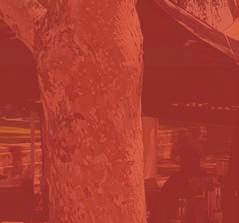

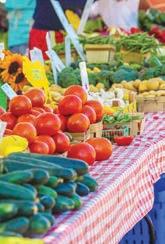



Known years ago as Marine World/Africa USA for its ocean and continental wildlife, Six Flags Discovery Kingdom is now known more for its rides. Take a topsy, turvy spin on the thriller coaster, Superman, or one of the many other thrill, family or children’s rides. See cougars and dolphins, walruses and penguins, among other animals. Take in a wildlife show, eat some food and take in an exhibit. The park also transforms during some holidays, adding special attractions for the Fourth of July, Halloween and Christmas celebrations. Season passes are available.
LOCATION: 1001 Fairgrounds Drive, Vallejo (From
Interstate 80, take the Discovery Kingdom exit)
MORE INFORMATION: 707-643-6722 for recorded information; 707-644-4000 for administrative office, www.sixflags.com/discoverykingdom
The Solano County Fair returns June 15-18 after a two-year virtual hiatus. The 2023 Solano County Fair is the 74th year in a row that Solano County has celebrated the special place that we all call home. Solano residents and visitors alike are invited to come for the carnival rides, the fair food, the entertainment


raising their animals. Equally important are the exhibits showcasing Solano’s artists, crafters, garden enthusiasts and more.
LOCATION: Solano County Fairgrounds, 900 Fairgrounds Drive
MORE INFORMATION: https://www.scfair.com
Vallejo’s Empress Theatre opened in February 1912, hosting a vaudeville act. It was re-opened in 2008 after nearly 20 years of non-use due to damage from the 1989 Loma Prieta earthquake. The one-room movie house has undergone complete renovation and seismic retrofit. Operated as a nonprofit, it now shows movies, hosts live performances and is rented for private events. Tours and sales of old movie posters also are offered.
LOCATION: 330 Virginia St., Vallejo
MORE INFORMATION: 707-552-2400,
www.empresstheatre.org

Acres of pure childhood joy await at this Vallejo park, with castles, a giant teapot, fire truck and other play structures as well as Cinderella’s carriage and modern play structures. A fully fenced park with plenty of high-imagination play areas, picnic facilities, open space, a craft area and an outdoor theater, Children’s Wonderland provides plenty of fun for the youngsters. Birthday party packages are available as well as multiple-visit passes.
LOCATION: 360 Glenn St., Vallejo


MORE INFORMATION: 707-980-8004, www.gvrd.org/?page=Childrens_Wonderland



Used by both commuters and tourists headed from Solano County to San Francisco, the San Francisco Bay Ferry, formerly the Vallejo Bay Ferry, offers another option to traveling to the interior Bay Area. The San Francisco Bay Ferry leaves the Vallejo waterfront several times daily to bring travelers across San Pablo Bay to the San Francisco Ferry Building. Ferry commuters avoid the traffic and get stunning views of the region. The trip takes about an hour. Some ferries also stop at Pier 41. In addition to the daily trips, the ferry offers special service to San
Francisco Giants games. There is a fee to park.

LOCATION: 289 Mare Island Way









MORE INFORMATION: 877-643-3779, www.sanfranciscobayferry.com



The Vallejo Naval and Historical Museum is a required stop for fans of local history and the Navy. The museum, which is located in Vallejo’s historic old City Hall, features five galleries devoted to the history and cultures of Vallejo and the U.S. Navy at Mare Island. It also sponsors educational and cultural programs. It is a lot of history to cover, because Vallejo traces its roots to 1844 with the arrival of Gen. Mariano
Vallejo, and Mare Island Naval Shipyard traces its own history to 1852, when Congress bought the island. While three of the galleries are devoted to permanent exhibits, the other two offer a constantly changing menu of visiting exhibits pulled from other museums and private collections. One of its more unusual features is the working submarine periscope that can be found at the top of the museum’s grand staircase, where visitors can get a sub’s-eye view of surrounding Vallejo.
LOCATION: 734 Marin St., Vallejo
MORE INFORMATION: 707-643-0077,





www.vallejomuseum.org



The former Mare Island Naval Shipyard was the first permanent naval installation on the West Coast when founded in 1854. It built more than 500 ships in its 142-year service to the United States before closing in 1996. Today, much of Mare Island’s historical artifacts are carefully being preserved by the Mare Island Historic Park Foundation. It’s housed in Building 46, a 50,000-square-foot space built in 1855.
LOCATION: 8th Street and 1100 Railroad Ave., Vallejo MORE INFORMATION: 707-644-4746 or 707-2805742; www.mareislandmuseum.org

